We went out during an informal pub crawl (not the one we first went to in the late afternoon via tourist bus) and ended up at Piccadilly Circus. I'm pretty sure we went to a bar that night called Dirty Dicks and I thought it was located there. We could have gone there before or after we ended up at Piccadilly. It had the lights and screens and looked like you would think it would look. :)
My biggest memory of that night was it was getting late (nearly 10pm) and the buses and the tube does not run after 10pm. I had to go to the bathroom as we were leaving, but I didn't want to get separated from my friends so I thought I can hold it.
We got to the tube station and waited and waited and waited and waited and waited and waited. I think we were there at least an hour. I was scared to run to the ladies room at the tube because I knew as soon as I separated from them, the train would come and I'd be stranded, have to hail a taxi or something. That wasn't acceptable.
The train finally came and we made it to Fulham Station about 4 blocks away and on the back side of the school. There was a huge tall brick wall and no way to get inside the complex other than to go to the front of the school where the guard was located. I was nearly crying. I remember spotting this one empty lot (dirt) and thought....could I do this (bushwack?) Well NO! This is a city street and anyone could see me. Not safe. So, I walked each painful step to the school. I grimaced at the guy at the guard shack. I walked gingerly down the hallway to the school water closet (see I said it right - not bathroom).... and when I got inside, I was there for a minute..... AHHHHHHH
I had waited so long my stomach was hurting. But by the time I got to my room, I was OK. :)
Piccadilly Circus is a road junction and public space of London's West End in the City of Westminster, built in 1819 to connect Regent Street with Piccadilly. In this context, a circus, from the Latin word meaning "circle", is a round open space at a street junction.[1]
Piccadilly now links directly to the theatres on Shaftesbury Avenue, as well as the Haymarket, Coventry Street (onwards to Leicester Square) and Glasshouse Street. The Circus is close to major shopping and entertainment areas in the West End. Its status as a major traffic junction has made Piccadilly Circus a busy meeting place and a tourist attraction in its own right. The Circus is particularly known for its video display and neon signs mounted on the corner building on the northern side, as well as the Shaftesbury memorial fountain and statue, which is popularly, though mistakenly, believed to be of Eros. It is surrounded by several notable buildings, including the London Pavilion and Criterion Theatre. Directly underneath the plaza is Piccadilly Circus tube station, part of the London Underground system.
History
Piccadilly Circus in 1949
Piccadilly Circus in 1896, with a view towards Leicester Square via Coventry Street. London Pavilion is on the left, and Criterion Theatre on the right.
Piccadilly Circus in 1962
Signs in 1992
Picadilly Circus in 2016
The junction has been a very busy traffic interchange since construction, as it lies at the centre of Theatreland and handles exit traffic from Piccadilly, which Charles Dickens, Jr. described in 1879: "Piccadilly, the great thoroughfare leading from the Haymarket and Regent-street westward to Hyde Park-corner, is the nearest approach to the Parisian boulevard of which London can boast."
The Piccadilly Circus tube station was opened 10 March 1906, on the Bakerloo line, and on the Piccadilly line in December of that year. In 1928, the station was extensively rebuilt to handle an increase in traffic. The junction's first electric advertisements appeared in 1910, and, from 1923, electric billboards were set up on the façade of the London Pavilion. Traffic lights were first installed on 3 August 1926.
During World War II many servicemen's clubs in the West End served American soldiers based in Britain. So many prostitutes roamed the area approaching the soldiers that they received the nickname "Piccadilly Commandos", and both Scotland Yard and the Foreign Office discussed possible damage to Anglo-American relations.[3]
At the start of the 1960s, it was determined that the Circus needed to be redeveloped to allow for greater traffic flow. In 1962, Lord Holford presented a plan which would have created a "double-decker" Piccadilly Circus; the upper deck would have been an elevated pedestrian concourse linking the buildings around the perimeter of the Circus, with the lower deck being solely for traffic, most of the ground-level pedestrian areas having been removed to allow for greater vehicle flow. This concept was kept alive throughout the rest of the 1960s. A final scheme in 1972 proposed three octagonal towers (the highest 240 feet (73 m) tall) to replace the Trocadero, the Criterion and the "Monico" buildings.[4] The plans were permanently rejected by Sir Keith Joseph and Ernest Marples; the key reason given was that Holford's scheme only allowed for a 20% increase in traffic, and the Government required 50%.
The Holford plan is referenced in the short-form documentary film "Goodbye, Piccadilly", produced by the Rank Organisation in 1967 as part of their Look at Life series when it was still seriously expected that Holford's recommendations would be acted upon. Piccadilly Circus has since escaped major redevelopment, apart from extensive ground-level pedestrianisation around its south side in the 1980s.
The Shaftesbury Memorial Fountain in Piccadilly Circus was erected in 1893 to commemorate the philanthropic works of Anthony Ashley Cooper, 7th Earl of Shaftesbury. During the Second World War, the statue atop the Shaftesbury Memorial Fountain was removed and was replaced by advertising hoardings. It was returned in 1948. When the Circus underwent reconstruction work in the late 1980s, the entire fountain was moved from the centre of the junction at the beginning of Shaftesbury Avenue to its present position at the southwestern corner.
Location and sights
Piccadilly Circus is surrounded by several major tourist attractions, including the Shaftesbury Memorial, Criterion Theatre, London Pavilion and several major retail stores. Numerous nightclubs, restaurants and bars are located in the area and neighbouring Soho, including the former Chinawhite club.
Panorama of Piccadilly Circus in 2015 from the southern side in front of Lillywhites
Illuminated signs
Illuminated signs of Piccadilly Circus at dawn, 2014
The Ballet of Change: Piccadilly Circus screening on the Coca-Cola Billboard, 2007
The earliest signs used incandescent light bulbs; these were replaced with neon lights and with moving signs (there was a large Guinness clock at one time). The first Neon sign was for the British meat extract Bovril.[6] From December 1998, digital projectors were used for the Coke sign, the square's first digital billboard,[7] while in the 2000s there was a gradual move to LED displays, which completely replaced neon lamps by 2011. The number of signs has reduced over the years as the rental costs have increased.
During 2017, the current six advertising screens will be combined into one large ultra-high definition curved Daktronics display, turning the signs off during renovation for the longest time since the 1940s. The current signs were switched off on 16 January 2017, with the new screen expected to take their place in the autumn.[8]
As of 2016, the site has six LED advertising screens above three large retail units facing Piccadilly Circus on the north side, occupied by Boots, Gap and a mix of smaller retail, restaurant and office premises fronting the other streets. A Burger King located under the Samsung advert, which had been a Wimpy Bar until 1989, closed in early 2008 and was converted into a Barclays Bank.
- Coca-Cola has had a sign at Piccadilly Circus since 1954.[9] The current placed sign dates from September 2003, when the previous digital projector board and the site that had been occupied by Nescafé was replaced with a state-of-the-art LED video display that curves round with the building. Before Nescafé, a neon advertisement for Foster's occupied the spot from 1987 until 1999, and from 1978 to 1987 it was used by Philips Electronics. On 23 November 2007, the first film was broadcast through the board. The screen also displays information about line closures and delays on the London Underground. Paul Atherton's film The Ballet of Change: Piccadilly Circus was allowed five minutes to show the first non-commercial film depicting the history of Piccadilly Circus and the lights. The former, for several months in 2002, replacing the Nescafé sign, was a sign featuring the quote "Imagine all the people living life in peace" by Beatle John Lennon. This was paid for by his widow Yoko Ono, who spent an estimated £150,000 to display an advert at this location.[10]
- Hyundai Motors sign launched on 29 September 2011.[11] It replaced a sign for Sanyo which had occupied the space since around early 1988 (slightly modified in 2004), the last to be run by traditional neon lights rather than Hyundai's computerised LED screen. Earlier Sanyo signs with older logos had occupied the position since 1978, although these were only half the size of the current space.[12]
- McDonald's added its sign in 1987, replacing one for BASF. The sign was changed from neon to LED in 2001. A bigger, brighter screen was installed by Daktronics in 2008.[13]
- Samsung added its sign in November 1994,[14] the space having been previously occupied by Canon (1978–84) and Panasonic (1984–94). The sign was changed from neon to LED in summer 2005. The screen was upgraded and improved in autumn 2011.
- One Piccadilly, the highest resolution of all the LED displays was installed by Daktronics, in late 2013, underneath the Samsung and McDonald's signs. It allows other companies to advertise for both short- and long-term leases, increasing the amount of advertising space but using the same screen for multiple brands. Prior to this an earlier, smaller LED screen called Piccadilly Lite occupied the space from 3 December 2007 to 2013. The space has also been occupied by JVC (1978–84), Carlsberg (1984–2003) and Budweiser (2003–07).
- The Curve, a similar space to One Picadilly, was added in 2015, replacing a space previously occupied by Schweppes (1920–61), BP (1961–67), Cinzano (1967–78), Fujifilm (1978–86), Kodak (1986–90) and TDK (1990-2015).[15] Burberry is currently using the space as of December 2015.
- LG were added in February 2007 on the roof of Coventry House, which diagonally faces Piccadilly Circus.[16] Their sign is a large LED video advertising display for LGE, the British arm of the South Korean electronics group. The new display also incorporates a scrolling ticker of Sky News headlines. Before LG, Vodafone had a neon sign installed on that spot, which displayed both their logo and personal messages that could be submitted on a special website and displayed at a certain time and date.
Other companies and brands that have had signs on the site were Bovril, Volkswagen, Max Factor, Wrigley's Spearmint, Skol, Air India and Gold Flake (as Will's Gold Flake Cigarettes).[18]
Shaftesbury Memorial and the statue of Anteros
Tourists sitting on the steps of the Shaftesbury Memorial Fountain
Criterion Theatre
The Criterion Theatre, a Grade II* listed building, stands on the south side of Piccadilly Circus. Apart from the box office area, the entire theatre, with nearly 600 seats, is underground and is reached by descending a tiled stairway. Columns are used to support both the dress circle and the upper circle, restricting the views of many of the seats inside.The theatre was designed by Thomas Verity and opened as a theatre on 21 March 1874, although original plans were for it to become a concert hall. In 1883, it was forced to close to improve ventilation and to replace gaslights with electric lights and was reopened the following year. The theatre closed in 1989 and was extensively renovated, reopening in October 1992.
London Pavilion
On the northeastern side of Piccadilly Circus, on the corner between Shaftesbury Avenue and Coventry Street, is the London Pavilion. The first building bearing the name was built in 1859 and was a music hall. In 1885, Shaftesbury Avenue was built through the former site of the Pavilion, and a new London Pavilion was constructed, which also served as a music hall. In 1924 electric billboards were erected on the side of the building.
Facade of the London Pavilion in 2002
Major shops
The former Swan & Edgar department store on the west side of the circus between Piccadilly and Regent Street was built in 1928–29 to a design by Reginald Blomfield.[20] Since the closure of the department store in the early 1980s, the building has been successively the flagship London store of music chains Tower Records, Virgin Megastore and Zavvi. The current occupier is clothing brand The Sting.Lillywhites is a major retailer of sporting goods located on the corner of the circus and Lower Regent Street, next to the Shaftesbury fountain. It moved to its present site in 1925. Lillywhites is popular with tourists, and they regularly offer sale items, including international football jerseys up to 90% off. Nearby Fortnum & Mason is often considered to be part of the Piccadilly Circus shopping area and is known for its expansive food hall.[21]
Underground station and the Bakerloo and Piccadilly lines
Inside Piccadilly Circus tube station
The station is on the Piccadilly line between Green Park and Leicester Square, and the Bakerloo line between Charing Cross and Oxford Circus.
Demonstrations
The Circus' status as a high-profile public space has made it the destination for numerous political demonstrations, including the February 15, 2003 anti-war protest[23] and the "Carnival Against Capitalism" protest against the 39th G8 summit in 2013.[24]Popular culture
Picadilly Circus, 1969; From the portfolio Untitled (Five Overpainted Picadilly Prints).
Piccadilly Circus has inspired artists and musicians. Piccadilly Circus (1912) is the name and subject of a painting by British artist Charles Ginner, part of the Tate Britain collection. Sculptor Paul McCarthy also has a 320-page two-volume edition of video stills by the name of Piccadilly Circus. Bob Marley mentioned Piccadilly Circus in his song "Kinky Reggae", on the Catch a Fire album from 1973.
L. S. Lowry R.A painting 'Piccadilly Circus, London' (1960), part of Lord Charles Forte's collection for almost three decades,[26] sold for £5,641,250 when auctioned for the first time at Christie's 20th Century British & Irish Art sale on 16 November 2011.[27]
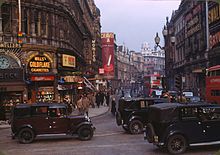


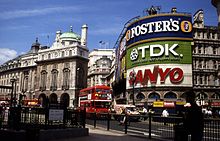




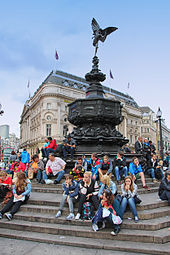
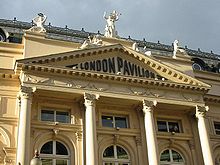
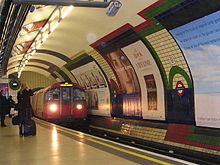

No comments:
Post a Comment